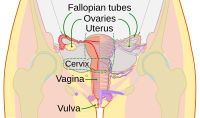
Photo from wikipedia
PURPOSE To present the acceptance and the commissioning, to define the reference dose, and to prepare the reference data for a quality assessment (QA) program of an ultra-high dose rate… Click to show full abstract
PURPOSE To present the acceptance and the commissioning, to define the reference dose, and to prepare the reference data for a quality assessment (QA) program of an ultra-high dose rate (UHDR) electron device in order to validate it for pre-clinical animal FLASH radiotherapy (FLASH RT) experiments and for FLASH RT clinical human protocols. METHODS The Mobetron® device was evaluated with electron beams of 9 MeV in conventional (CONV) mode and of 6 MeV and 9 MeV in UHDR mode (nominal energy). The acceptance was performed according to the acceptance protocol of the company. The commissioning consisted of determining the short- and long-term stability of the device, the measurement of percent depth dose curves (PDDs) and profiles at two different positions (with two different dose per pulse regimen) and for different collimator sizes, and the evaluation of the variability of these parameters when changing the pulse width and pulse repetition frequency. Measurements were performed using a redundant and validated dosimetric strategy with alanine and radiochromic films, as well as Advanced Markus ionization chamber for some measurements. RESULTS The acceptance tests were all within the tolerances of the company's acceptance protocol. The linearity with pulse width was within 1.5% in all cases. The pulse repetition frequency (PRF) did not affect the delivered dose more than 2% in all cases but 90 Hz, for which the larger difference was 3.8%. The reference dosimetry showed a good agreement within the alanine and films with variations of 2.2% or less. The short-term (resp. long-term) stability less than 1.0% (resp. 1.8%) and were the same in both the CONV and UHDR modes. PDDs, profiles, and reference dosimetry were measured at two positions, providing data for two specific dose rates (about 9 Gy/pulse and 3 Gy/pulse). Maximal beam size was 4cm and 6cm at 90% isodose in the two positions tested. There was no difference between CONV and UHDR mode in the beam characteristics tested. CONCLUSIONS The device is commissioned for FLASH RT preclinical biological experiments as well as FLASH RT clinical human protocols.
Journal Title: Medical physics
Year Published: 2021
Link to full text (if available)
Share on Social Media: Sign Up to like & get
recommendations!